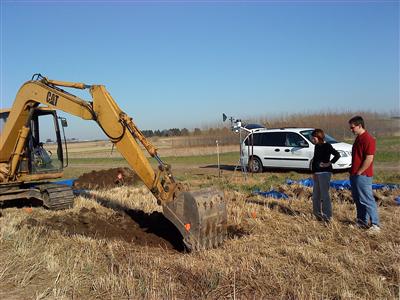
Credit: Damodhar Mailapalli
February 28, 2012
By Aaron R. Conklin
At the Great Lakes Research Center’s research plots in Arlington, Wis., a key part of the biofuel industry’s future is taking shape, one model cropping system at a time.
Or more accurately, through eight different model cropping systems planted across a gradient of diversity.
To maintain a successful production and profit model for biofuel production (read: ethanol) crops require a high yield—hence the biofuel industry’s current preference for relying on continuous corn, a crop with routinely spectacular yields. But while corn has obvious yield advantages, a lack of crop diversity also carries some significant ecological drawbacks for both soil and groundwater, which is what has led farmers and researchers to explore other options, from switchgrass to leaves from certain types of hybrid trees.
Since 2008, a team of researchers led by Randy Jackson, a University of Wisconsin-Madison professor of agronomy, has been trying to assess the sustainability and characteristics of these different types of crops, in the hopes of developing a database of information to guide future cropping efforts.
Using funds provided by the Water Resources Institute, a group led by Anita Thompson, a UW-Madison associate professor of biological systems engineering, is working with Jackson to examine and evaluate the groundwater quantity and quality in five of the eight systems at the research center: continuous corn; switchgrass; hybrid poplar trees; a corn, soybean and canola three-year rotation; and, finally, miscanthus giganteus, a tall-growing tropical grass with invasive properties.
Every few weeks, Thompson’s crew heads out to Arlington to collect leachate water out of lysimeters placed a meter or so in the ground. The leachate volumes and levels of nitrogen, phosphorous and organic carbon Thompson finds reveal truths about how each cropping system contributes to groundwater recharge, the hydrological process through which surface water becomes groundwater.
Despite pressure from several camps in the biofuel industry, the ultimate goal of Jackson and Thompson’s research isn’t to produce a ranked hierarchy of cropping systems.
“It isn’t our goal to say that this cropping system is better than this other one,” said Thompson. “What we’re really looking for is a better understanding of the complete profile, so farmers and policy makers can make better-informed decisions.”
Jackson agrees. “Ultimately, we hope to populate a big database that gets used in a modeling effort,” he explained. “So we can turn the dials and say, ‘Okay, so if you’re going to put switchgrass into this kind of a landscape in this position on the landscape, and here’s what ecosystems services are likely, you’re going to increase nitrate in the soil water more than what used to be there’.”
High nitrates have been linked to negative human and animal health effects.
Groundwater quality and quantity are obviously two critical axes in a cropping system’s ecosystems service model, which is what makes Thompson’s efforts so important.

Credit: Debby Sumwalt
“Some of what we’re discovering comes down to the characteristics of the plants,” said Thompson. “How deep do the roots penetrate? Crops without a lot of ground cover have more potential for runoff. Those with more dense vegetation tend to absorb water better.”
Other factors include the ways in which different plants absorb nutrients, and how much of the plant is above and below the ground. Switchgrass, for instance, has remarkably deep roots, capable of trapping and sucking up water at a more efficient rate than, say, poplar trees.
The data Thompson’s compiling will eventually be combined with regional water quality and quantity data to further develop, parameterize and validate a new biogeophysical hydrology model developed by her project collaborators at Michigan State University, where these same model cropping systems are being duplicated. Researchers hope the model can be used to explore the implications of climate change and biofuel-based land use changes for Great Lakes Basin water quantity and quality.
Thompson’s part of the project is still in its earliest phases and her group is still another full growing season away from generating their first round of meaningful results. That said, small discoveries are beginning to emerge. Like the fact that during the first year nitrate loads in leachate were significantly higher for continuous corn than for switchgrass.
“Of course that also could be due to differences in fertilizer,” cautioned Thompson. “Long-term monitoring is what’s really important here. That’s what’s going to help us determine the sustainability of these cropping systems. We’re just looking at once piece of the picture. “



